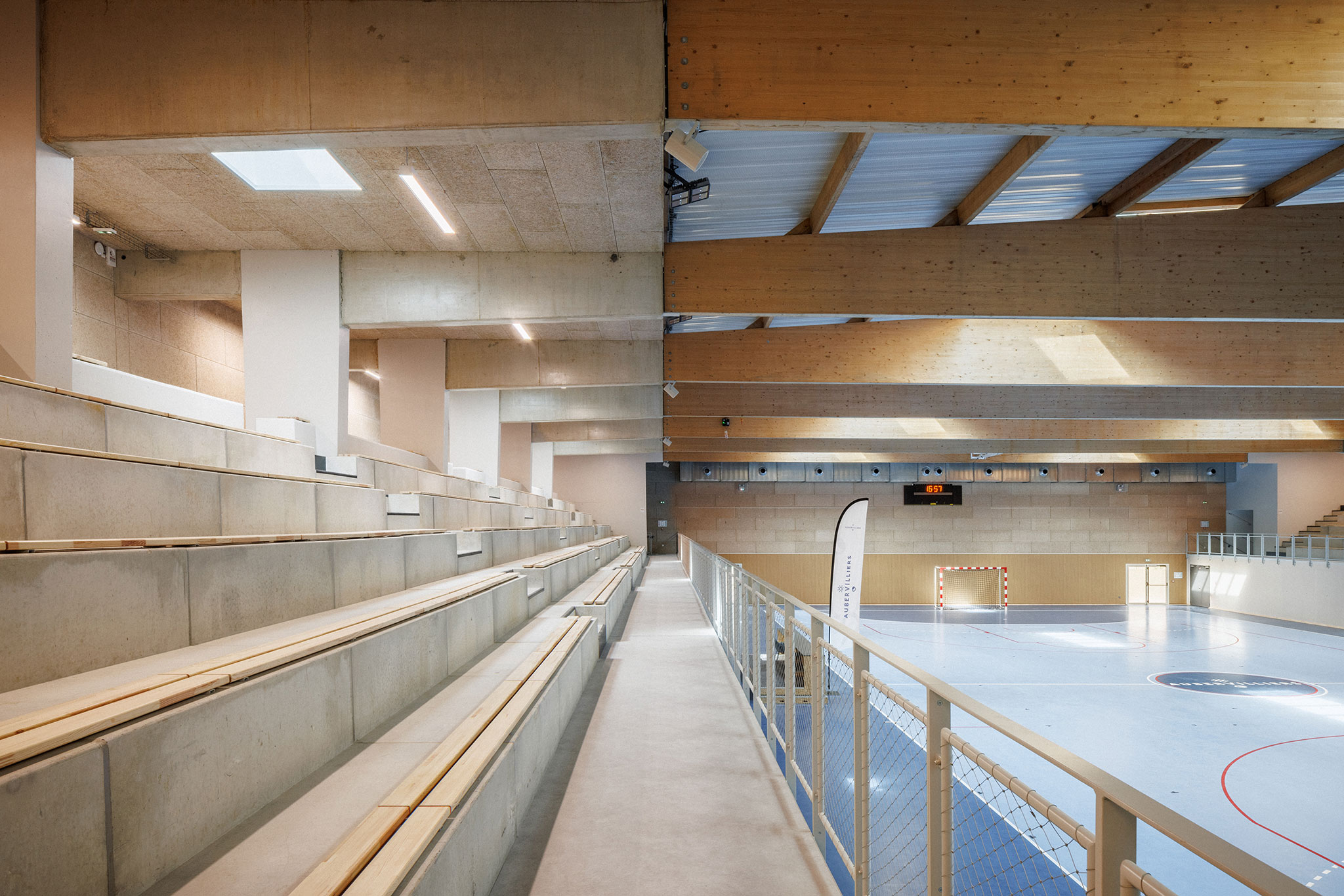
The project developed by Atelier Aconcept takes advantage of the characteristics of its surrounding environment to create views into the gymnasium. The setback from the street structures the public space and allows access to the interior, directing users towards the different areas of the facility around the main court, which separates the flows of spectators and athletes.
In the sports court, natural light flows into the interior thanks to the skylights that pierce the roof, while in the rest of the spaces, solar protection systems regulate the intensity of the lighting depending on the needs. With great responsibility, the project takes advantage of the demolished concrete, metal or wood that has been recovered from the old construction seeking to achieve a sustainable construction.

Guy Môquet gymnasium by Atelier Aconcept. Photograph by 11h45.
Project description by Atelier Aconcept
Following demolition and reconstruction work for the city, the team comprising Atelier Aconcept (architect) and Defillon (lead contractor) delivered the new Guy Môquet gymnasium in Aubervilliers (Greater Paris) in July 2024. The refurbishment gives structure to the public space.
Deconstructed and rebuilt by Atelier Aconcept, the Guy Môquet gymnasium provided a training venue for the Paris 2024 Olympic and Paralympic Games, but its legacy is a multi-sports hall designed not only for top-level sportsmen and women, but also for schools, associations (meetings for local residents) and resident clubs, giving it a national and local profile. In the town centre, the gymnasium is located close to other public facilities (local theatre, regional conservatoire, Saint-John Perse media library, etc.) and in the continuity of these urban focal points, with a facade that opens onto the town and communicates with the adjacent Parc Stalingrad.
The covered forecourt, set back from the street, structures the public space and provides access to the facility. Open to its surroundings on all four sides, the building takes advantage of the special features of Parc Stalingrad. To the east, the landscaping opens up views between the inside of the gymnasium and the petanque courts, while providing seating between the two entities. The pathways created along these façades and the visual porosity to the south offer pedestrians the spectacle of the sporting activity, with the northern facade becoming a ‘backdrop’ along the pedestrian walkway.

The Guy Môquet gymnasium, demonstrator of sustainable construction
The new Guy Môquet gymnasium, located at 28 rue Edouard Poisson in Aubervilliers (Greater Paris) on the site where the old one was demolished, is a new-generation building. Delivered in July 2024 by the architectural firm Aconcept, it is an example of sustainable development applied to a high-level sports facility.
Who remembers the old Guy Môquet gymnasium? Today, on the same site, stands a brand new facility that was used as a handball training centre during the Paris 2024 Olympic and Paralympic Games. Now in its heritage period, it is open to all residents, top sportsmen and women, schools, associations and resident clubs. Built at a cost of €8 million, the stadium is intended to have a local and national impact. The fixed stands in the Palais des Sports, with a capacity of 900, can be supplemented by removable stands.

Inscribed in the site
By opening up to its surroundings on all four sides, the covered forecourt, set back from the street, structures the public space and provides access to the facility. Taking advantage of the special features of the adjacent Parc Stalingrad, the landscaping creates views between the interior of the gymnasium and the petanque courts. To the south, the visual porosity highlights the spectacle of sport, with the north facade providing a ‘backdrop’ along the pedestrian walkway. The structure is a raised, stone-tone mineral monolith, with the glazed strip on which it rests giving it an airy appearance. The sports hall offers spectators a bird's-eye view of the action on the pitch.
Between the forecourt and the inside of the gymnasium, visitors discover a generously dimensioned hall and a space that is singular in its dimensions and materiality. As well as acting as a buffer space, it encourages social interaction and allows the public space to be used in a variety of ways. It also directs users to all areas of the facility, while separating spectator and sports flows.

Circular economy
Environmental considerations were a determining factor in the choice of architecture, materials and colours used. In fact, 90% of the demolished concrete was recovered, recycled and reused, and 98% of the demolition waste (wood, metal and concrete) was reclaimed, all contributing to the demonstration of sustainable construction.
The roof, pierced by skylights and illuminated by natural light, is planted and extends the green grid. Appropriate solar protection systems regulate solar gain while avoiding glare for users. The landscaped area is a mineral and plant surface covering the entire outdoor floor area and offering shaded areas, with open ground accounting for more than 58% of the outdoor spaces. The plot will also be home to 47 trees (including two large trees, 15 medium trees and 30 small trees and vines).
The photovoltaic panels installed on the structure will enable local production of 14.8 kWhEF/m², corresponding to around 31% of electricity needs. The renewable energy rate achieved by the project is around 60%. The building has been awarded the Label Biosourcé level 1, the NF HQE reference for sports facilities.




































